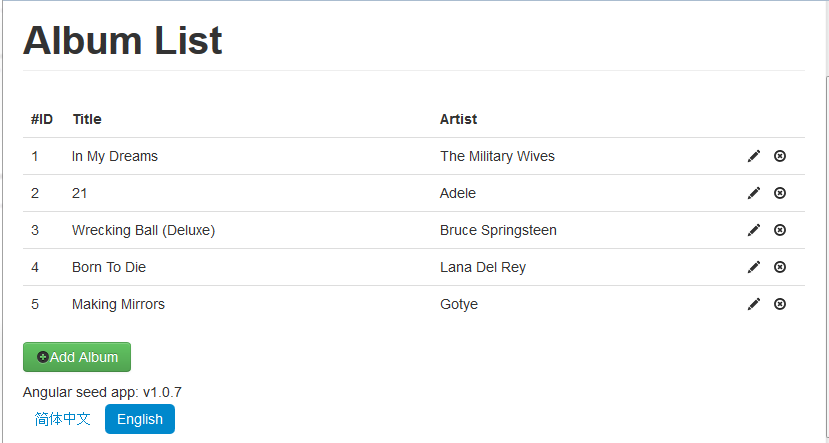-
Notifications
You must be signed in to change notification settings - Fork 28
create project
#Create a restful application with AngularJS and Zend 2 framework
This example application uses AngularJS/Bootstrap as frontend and Zend2 Framework as REST API producer.
##The backend code
This backend code reuses the database scheme and codes of the official Zend Tutorial, and REST API support is also from the Zend community.
Zend2 provides a AbstractRestfulController for RESR API producing.
class AlbumController extends AbstractRestfulController {
public function getList() {
$results = $this->getAlbumTable()->fetchAll();
$data = array();
foreach ($results as $result) {
$data[] = $result;
}
return new JsonModel(array(
'data' => $data)
);
}
public function get($id) {
$album = $this->getAlbumTable()->getAlbum($id);
return new JsonModel(array("data" => $album));
}
public function create($data) {
$data['id']=0;
$form = new AlbumForm();
$album = new Album();
$form->setInputFilter($album->getInputFilter());
$form->setData($data);
$id=0;
if ($form->isValid()) {
$album->exchangeArray($form->getData());
$id = $this->getAlbumTable()->saveAlbum($album);
}else {
print_r( $form->getMessages());
}
return new JsonModel(array(
'data' => $id,
));
}
public function update($id, $data) {
$data['id'] = $id;
$album = $this->getAlbumTable()->getAlbum($id);
$form = new AlbumForm();
$form->bind($album);
$form->setInputFilter($album->getInputFilter());
$form->setData($data);
if ($form->isValid()) {
$id = $this->getAlbumTable()->saveAlbum($form->getData());
}
return new JsonModel(array(
'data' => $id,
));
}
public function delete($id) {
$this->getAlbumTable()->deleteAlbum($id);
return new JsonModel(array(
'data' => 'deleted',
));
}
protected $albumTable;
public function getAlbumTable() {
if (!$this->albumTable) {
$sm = $this->getServiceLocator();
$this->albumTable = $sm->get('Album\Model\AlbumTable');
}
return $this->albumTable;
}
}
The naming convention of the methods for REST API is listed in the following table.
| URL | HTTP Method | Controller Method | Description |
| /albums | GET | getList | Get the list of Albums |
| /albums | POST | create | Create a new Album |
| /albums/:id | GET | get | Get the details of a Album |
| /albums/:id | PUT | udpate | Update a Album by id |
| /albums/:id | DELETE | delete | Delete a Album by id |
Besides the naming convention, you have to set the routing rule to make it work.
Change the content of module/Album/config/module.config.php to the following.
<?php
return array(
'controllers' => array(
'invokables' => array(
'Album\Controller\Album' => 'Album\Controller\AlbumController',
),
),
// The following section is new and should be added to your file
'router' => array(
'routes' => array(
'album' => array(
'type' => 'segment',
'options' => array(
'route' => '/albums[/:id]',
'constraints' => array(
'id' => '[0-9]+',
),
'defaults' => array(
'controller' => 'Album\Controller\Album'
),
),
),
),
),
'view_manager' => array(
'strategies' => array(
'ViewJsonStrategy',
),
),
);
For producing REST API, it needs render a JSON view instead of the HTML view.
It is very similar with the before AngularJS CakePHP application and AngularJS Grails application.
I do not want to duplicate the codes in this post, please checkout the codes github.com.
https://github.com/hantsy/angularjs-zf2-sample
Clone the source from github.com.
git clone https://github.com/hantsy/angularjs-zf2-sample
Run php composer.phar install to install the depencies automaticially. This applicalication also used Composer to manage the dependencies.
Create a vhost setting in Apache for this application, set the value of the DocumentRoot is <your application path>/public.
<VirtualHost *:80>
ServerName zf2-tutorial.localhost
DocumentRoot E:/MyWorks/hantsy-labs/angularjs-zf2-sample/public
SetEnv APPLICATION_ENV "development"
<Directory E:/MyWorks/hantsy-labs/angularjs-zf2-sample/public>
DirectoryIndex index.php
AllowOverride All
Order allow,deny
Allow from all
</Directory>
</VirtualHost>
Change the database setting(username and password) in the config/autoload/local.php.
return array(
'db' => array(
'username' => 'root',
'password' => '',
),
);
Start apache server.
Open browser, navigate to http://zf2-tutorial.localhost/app/index.html#/albums.

##Sample codes
Clone the sources from my github.com.
git clone https://github.com/hantsy/angularjs-zf2-sample
And switch to stage1 branch.
git checkout stage1